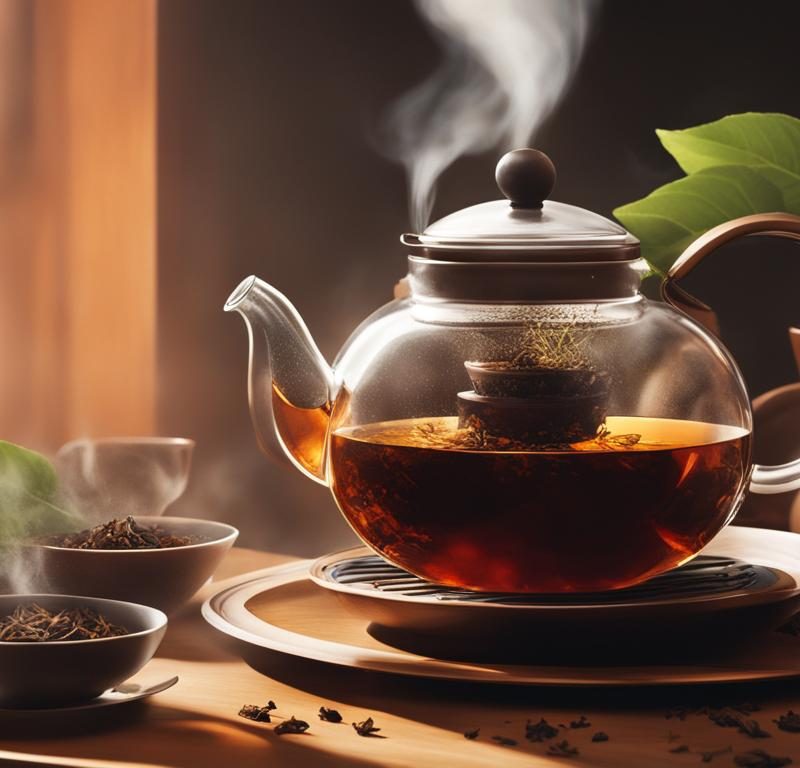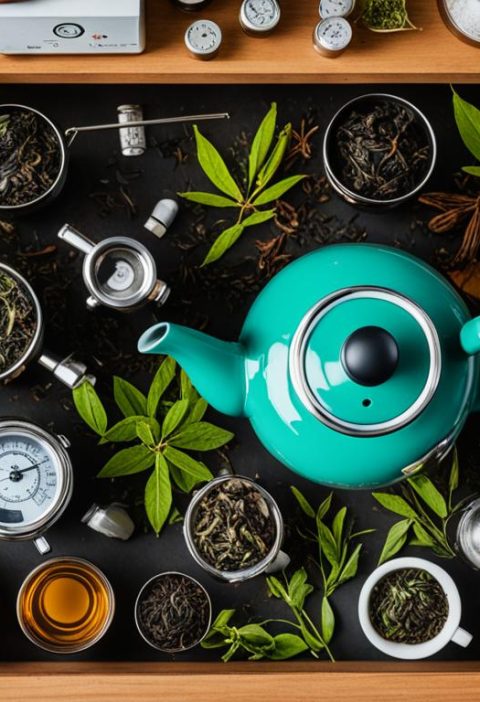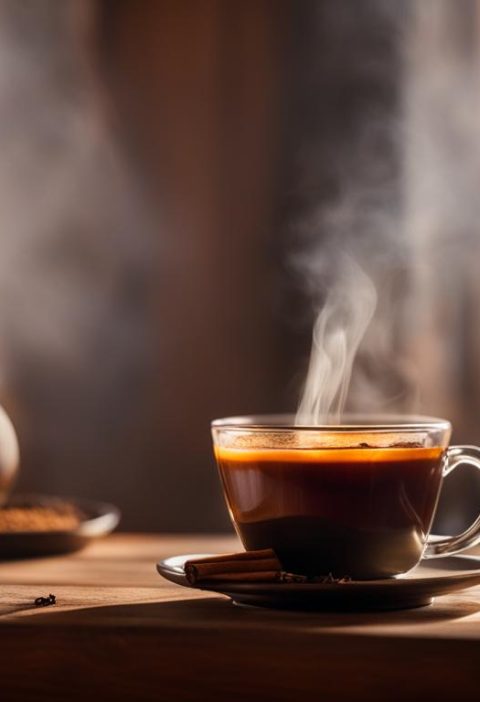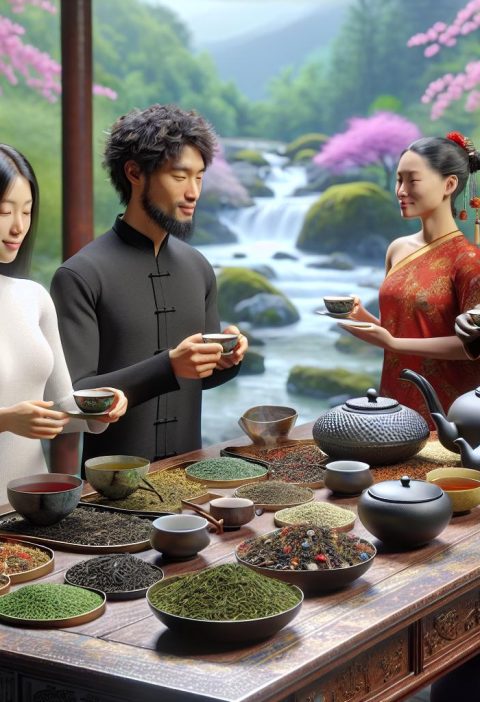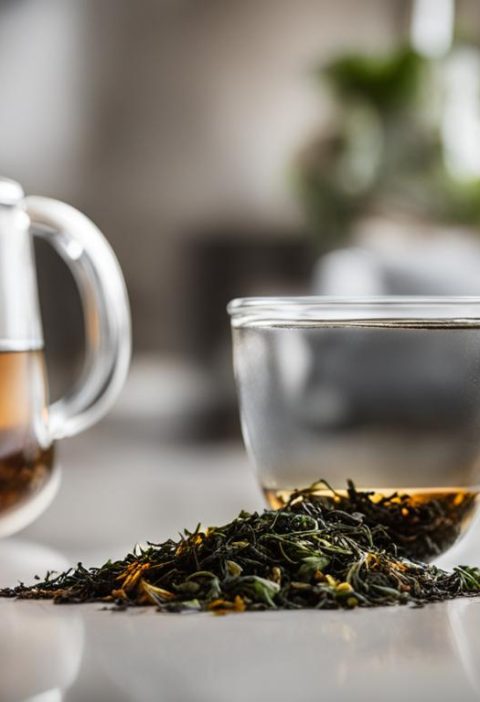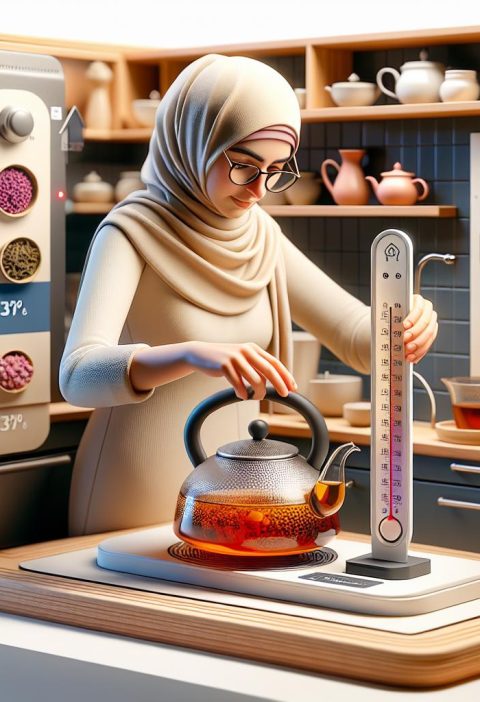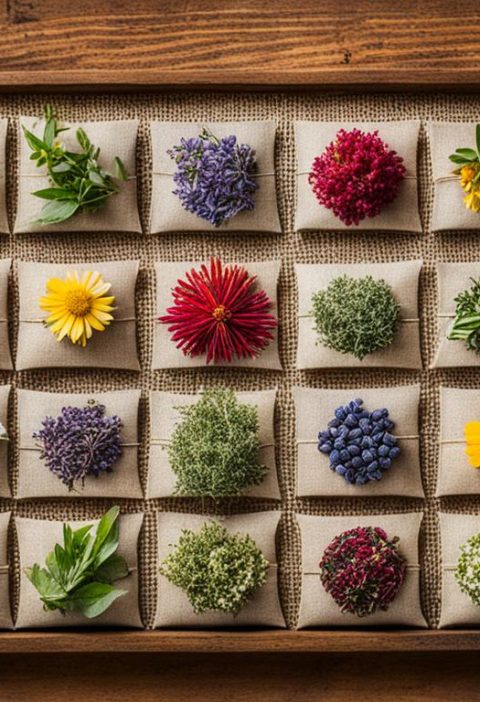Steeping tea is more than just a simple process of making a cup of tea. It is an art that requires knowledge, precision, and a deep understanding of the intricate flavors that tea can offer. By mastering the art of steeping, you can enhance the flavors of your tea and unlock its full potential. In this article, we will explore different tea brewing techniques, flavor extraction methods, and essential tips to help you maximize the taste of your tea. So, whether you are a tea connoisseur or a beginner, join us on this tea-steeping journey to elevate your tea-drinking experience.
Key Takeaways:
- Proper steeping can enhance the flavors of your tea and unlock its full potential.
- Different types of tea require different steeping techniques and times.
- Using fresh and high-quality ingredients can enhance the flavors of your brew.
- Steeping time and water temperature play important roles in achieving optimal flavor.
- Experimentation and finding your own preferences are key to brewing the perfect cup of tea.
Understanding Different Types of Tea
When it comes to tea, there is a world of variety to explore. Understanding the different types of tea can help you make the most of your brewing experience. From classic true teas to herbal infusions, each type offers unique flavors, aromas, and health benefits.
True Teas
True teas, made from the leaves of the Camellia sinensis plant, include black, green, oolong, and white tea. Each true tea variety undergoes different processing methods, resulting in distinct flavors and appearances.
- Black Tea: Known for its bold, robust flavor and dark color, black tea is fully oxidized and has the highest caffeine content among true teas.
- Green Tea: Unoxidized and gently processed, green tea retains its natural antioxidants and offers a refreshing, grassy taste.
- Oolong Tea: Partially fermented, oolong tea strikes a balance between the rich flavors of black tea and the fresh character of green tea.
- White Tea: The least processed of the true teas, white tea has a delicate flavor profile and contains the highest levels of antioxidants.
Herbal Teas
In addition to true teas, herbal teas, also known as tisanes, are popular for their soothing properties and diverse flavors. Unlike true teas, herbal infusions are derived from herbs, flowers, fruits, and spices.
Here are some common herbal teas:
- Hibiscus Tea: Known for its vibrant crimson color, hibiscus tea delivers a tangy and slightly tart taste.
- Peppermint Tea: With its cooling menthol flavor, peppermint tea is refreshing and may aid in digestion.
- Chamomile Tea: Often enjoyed for its calming effects, chamomile tea has a mild, floral taste.
- Ginger Tea: Spicy and invigorating, ginger tea can provide warmth and soothing relief.
Unlike true teas that follow specific steeping times and water temperatures, herbal teas offer more flexibility. You can experiment with steeping times and temperatures to find the perfect balance of flavors for your taste preferences.
Now that we have explored the different types of tea, let’s move on to understanding the importance of using fresh ingredients in section 3.
The Importance of Fresh Ingredients
Using fresh ingredients is crucial when it comes to brewing tea that bursts with flavor. Whether you’re making herbal teas with herbs like mint or chamomile, or steeping true teas like black or green tea, using fresh ingredients can make a significant difference in taste and aroma.
While dried ingredients, such as tea leaves, may have a longer shelf life, they can experience flavor degradation over time. The freshness of the ingredients directly impacts the quality of the tea. Fresh ingredients have vibrant flavors and aromas that can elevate your tea-drinking experience.
Flavor Degradation and Shelf Life
Tea leaves, when properly stored, can remain fresh and flavorful for an extended period. However, over time, exposure to air, light, and moisture can lead to flavor degradation. The delicate compounds within tea leaves can break down, resulting in a loss of aroma and taste.
To ensure the highest tea quality and optimal flavor, it’s recommended to use fresh ingredients and purchase teas from reputable sources that prioritize freshness. Pay attention to the shelf life and storage recommendations provided by the manufacturer or supplier. This way, you can enjoy the true essence of the tea without any flavor compromises.
Choosing Fresh Ingredients
When selecting fresh ingredients for tea, look for vibrant colors, strong aromas, and intact leaves or herbs. Avoid ingredients that appear dull, have a lack of fragrance, or contain any signs of spoilage. Freshness is key in capturing the full range of flavors and aromatic profiles.
In the case of loose leaf teas, opt for whole leaves instead of broken or fragmented ones. Whole leaves often retain more essential oils, resulting in a more aromatic and flavorful brew. Additionally, whole tea leaves can undergo multiple infusions, allowing you to extract different layers of flavors from a single batch.
Summary
Incorporating fresh ingredients into your tea brewing routine is essential for maximizing the flavor and quality of your brew. Whether it’s herbs, spices, or tea leaves, freshness ensures that you experience the true essence and complexity of the ingredients. By prioritizing fresh ingredients, you can elevate your tea-drinking experience and enjoy a truly satisfying cup of tea.
Time and Temperature Guidelines
When it comes to steeping tea, the right time and temperature can make all the difference in the flavors and strength of your brew. While there are general guidelines to follow, it’s important to experiment and find what suits your taste preferences.
Steeping tea at a temperature that is too hot or for too long can result in a bitter or overly strong tea. On the other hand, steeping at a temperature that is too low or for too short a time may result in a weak or under-extracted brew.
Caffeine content can also be affected by steeping time and temperature. Longer steeping times and higher water temperatures can often result in higher levels of caffeine in your tea.
To help you maximize the flavor and strength of your tea, here are some general time and temperature guidelines for different types of tea:
Black Tea
- Water Temperature: 195°F – 205°F (90°C – 96°C)
- Steeping Time: 3 – 5 minutes
Green Tea
- Water Temperature: 160°F – 180°F (71°C – 82°C)
- Steeping Time: 1 – 3 minutes
Oolong Tea
- Water Temperature: 190°F – 200°F (88°C – 93°C)
- Steeping Time: 3 – 5 minutes
White Tea
- Water Temperature: 160°F – 180°F (71°C – 82°C)
- Steeping Time: 2 – 3 minutes
These are just general guidelines, and it’s important to adjust the time and temperature based on your personal preferences. Remember, the key is to find the sweet spot that brings out the best flavors in your tea without overpowering or diluting them.
Experiment with different steeping times and water temperatures to find the combination that suits your taste buds. Enjoy the journey of discovering the perfect brew!
Hot Steeping Techniques
Hot steeping is the most common method of brewing tea. When it comes to hot steeping, different types of tea require specific steeping times and water temperatures to achieve optimal flavor. Let’s explore the recommended guidelines for various types of tea:
White Tea
White tea is delicate and possesses subtle flavors, so it requires lower water temperatures and shorter steeping times to preserve its taste. We recommend steeping white tea at a temperature of around 175°F (80°C) for approximately 2-3 minutes.
Green Tea
Green tea is known for its grassy and vegetal flavors. To bring out the best flavors in green tea, steep it at a slightly higher temperature between 160-180°F (71-82°C) for 2-3 minutes. Avoid using boiling water, as it can result in a bitter taste.
Oolong Tea
Oolong tea falls between the range of green and black tea and offers a diverse range of flavors. For oolong tea, use water temperatures around 190-200°F (88-93°C) and steep it for 3-5 minutes. Adjust the steeping time depending on your preferred strength of the brew.
Black Tea
Black tea is robust and bold in flavor, making it more tolerant to higher water temperatures and longer steeping times. Steeping black tea at temperatures of 200-212°F (93-100°C) for 3-5 minutes helps extract its full flavor potential.
Herbal Tea
Herbal teas encompass a wide variety of ingredients, each with their own unique flavors and steeping requirements. In general, herbal teas can withstand higher temperatures and longer steeping times. We recommend steeping herbal teas at temperatures around 200°F (93°C) for 5-7 minutes to allow for maximum flavor extraction.
Remember, these recommended guidelines provide a starting point, but feel free to adjust the steeping time and temperature based on your personal taste preferences. Now that we understand the hot steeping techniques for different types of tea, let’s move on to exploring cold steeping techniques in the next section.
| Type of Tea | Water Temperature | Steeping Time |
|---|---|---|
| White Tea | 175°F (80°C) | 2-3 minutes |
| Green Tea | 160-180°F (71-82°C) | 2-3 minutes |
| Oolong Tea | 190-200°F (88-93°C) | 3-5 minutes |
| Black Tea | 200-212°F (93-100°C) | 3-5 minutes |
| Herbal Tea | 200°F (93°C) | 5-7 minutes |
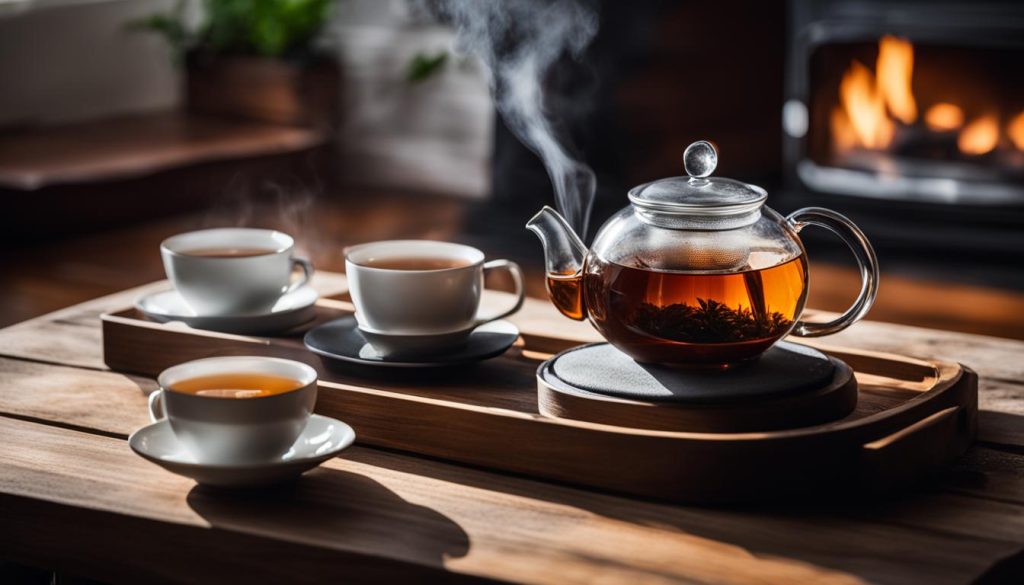
Cold Steeping Techniques
Cold steeping is an alternative method for brewing tea, especially if you prefer iced tea. It offers a smoother and less bitter flavor profile compared to hot steeping, making it a popular choice for tea enthusiasts. Cold steeping also allows for the retention of higher levels of antioxidants, providing additional health benefits.
Steeping Time and Temperature
Cold steeping requires longer steeping times at lower temperatures compared to hot steeping. The typical steeping time for cold brewing is around 8 to 12 hours, allowing the tea leaves to slowly release their flavors and infuse the water. The steeping temperature ranges from 35°F to 50°F (2°C to 10°C), providing a gentle and gradual extraction process.
To achieve a similar flavor profile in a shorter amount of time, you can opt for quick alternatives such as steeping the tea at a slightly higher temperature for a shorter duration. This method can produce comparable results in terms of flavor and antioxidant content.
The Benefits of Cold Steeping
- Cold steeping results in a smoother and more mellow taste compared to hot steeping, making it ideal for iced tea.
- The lower temperature used in cold steeping helps to preserve the delicate flavors and aromas of the tea.
- Cold steeping extracts a higher level of antioxidants from the tea leaves, providing added health benefits.
- It can be a convenient brewing method as it requires minimal equipment and can be prepared in advance.
Overall, cold steeping offers a refreshing and flavorful alternative to hot steeping, allowing you to enjoy the goodness of tea in a different way. Whether you prefer a traditional cold brew or a quick alternative, experimenting with cold steeping techniques can enhance your tea brewing repertoire.
Tools and Techniques for Steeping Tea
When it comes to steeping your tea, there are various tools and techniques available to help you achieve the perfect brew. Whether you prefer the convenience of tea bags or the versatility of loose leaf tea, having the right tools can enhance your tea-drinking experience.
Tea Steeping Tools
If you’re just starting your tea journey, basic tools like a teacup and kettle are essential. Teacups come in various sizes and designs, allowing you to choose the one that suits your style. Investing in a high-quality kettle ensures precise control over water temperature, a critical factor for optimal flavor extraction.
If you prefer loose leaf tea, using a metal tea ball or infuser is recommended. These tools prevent loose tea leaves from floating freely in your cup while allowing water to circulate and extract flavor. With a metal tea ball or infuser, you can easily remove the leaves once your tea has steeped to your desired strength.
Brewing Loose Leaf Tea
One of the advantages of brewing loose leaf tea is the ability to customize your teas by blending different varieties or adding ingredients like dried fruits or herbs. To brew loose leaf tea, you will need a few additional tools:
- A tea infuser or strainer: This allows the water to flow through the leaves while trapping any debris, resulting in a smoother cup of tea.
- A teapot or brewing vessel: Choose a teapot or brewing vessel that allows the tea leaves to expand and infuse properly. Consider factors such as material and size to ensure optimal flavor extraction.
- A timer: Steeping time plays a crucial role in brewing loose leaf tea. Use a timer to keep track and achieve consistent results.
When brewing loose leaf tea, experimentation is key. Adjust steeping time, water temperature, and tea-to-water ratio to find the perfect balance and unlock the full potential of your tea leaves.
Cold-Brewed Tea
Cold-brewed tea offers a refreshing alternative to hot steeping, especially during warmer months. To cold brew tea, you will need:
- A larger container: Use a pitcher or a jar to accommodate the tea leaves and water for cold brewing. Make sure it has a tight lid or cover to prevent any contaminants from affecting the brew.
- Loose leaf tea or tea bags: Choose your favorite tea blend, whether it’s green tea, herbal tea, or black tea, and add it to the container.
- Cold water: Unlike hot steeping, cold brewing requires lower water temperatures. Fill the container with cold water, covering the tea leaves.
Refrigerate the container and let the tea steep for several hours, preferably overnight, allowing for a slow and gentle extraction process. The result is a smooth and naturally sweet tea with lower caffeine content.
The Impact of Palate and Serving Size
Your palate and the serving size of tea can have a significant impact on the flavor of your brew. Let’s explore how these factors influence your tea-drinking experience.
The Changing Palate:
Our sense of taste is not static; it can change based on various factors, such as the foods we consume or even having a cold. These changes can influence how we perceive flavors and aromas in our tea. For example, eating strongly flavored food beforehand can temporarily alter our taste receptors, making the tea taste different than usual.
Tea Density and Strength:
Different types of tea have varying densities, which can affect the strength of the brew. Dense teas, like tightly rolled oolong leaves, may require a longer steeping time to fully extract their flavors. On the other hand, less dense teas, like delicate white tea buds, may release their flavors quickly and result in a stronger brew even with a shorter steeping time.
In order to achieve the desired flavor profile, you can adjust the serving size of your tea. By using more or fewer tea leaves when preparing your brew, you can control the intensity of the flavor. A stronger brew can be achieved by increasing the amount of tea leaves, while a milder brew can be achieved by reducing the serving size.
Adjusting Serving Size for Tea Strength
| Serving Size | Tea Strength |
|---|---|
| 1 teaspoon of tea | Light and Mild |
| 2 teaspoons of tea | Moderate |
| 3 teaspoons of tea | Strong |
Remember to experiment and find the right balance that suits your personal taste preferences. Adjusting the serving size allows you to tailor the strength of your tea to your liking, ensuring a delightful and personalized tea experience.
Next, we will explore the impact of water temperature on tea flavor and how to adjust steeping time for optimal results. Keep reading to discover more about the art of tea steeping!
Water Temperature and Its Effect on Flavor
When it comes to steeping tea, water temperature plays a crucial role in determining the flavor of your brew. Different types of tea require specific water temperatures to achieve the best taste. Let’s explore how the water temperature impacts the flavors, especially when it comes to delicate teas like green tea.
Delicate teas, such as green tea, have more subtle flavors that can easily be overwhelmed or ruined by boiling water. Too high of a water temperature can result in burnt tea leaves and bitter brews. To avoid these unpleasant flavors, it’s important to use lower water temperatures when steeping delicate teas.
Green Tea and Water Temperature
Green tea is known for its fresh and grassy flavors. To bring out the delicate flavors and avoid bitterness, it’s recommended to steep green tea in water that is around 160°F to 180°F (70°C to 82°C). This lower temperature allows the flavors to develop without extracting any unwanted bitterness.
Boiling water, with a temperature of 212°F (100°C), is far too hot for green tea. Steeping green tea in boiling water can result in a harsh and bitter taste that masks the natural flavors. It’s essential to have the right water temperature to fully enjoy the nuanced flavors of green tea.
Adjusting Water Temperature for Other Teas
While delicate teas like green tea require lower water temperatures, other teas can withstand higher temperatures without compromising their flavors. For example, black tea can be steeped in boiling water, as its robust flavors can handle the higher temperature.
We have summarized the recommended water temperatures for various tea types in the table below:
| Tea Type | Recommended Water Temperature |
|---|---|
| Green Tea | 160°F to 180°F (70°C to 82°C) |
| Black Tea | Boiling water (212°F / 100°C) |
| Oolong Tea | 190°F to 200°F (88°C to 93°C) |
| White Tea | 170°F to 185°F (77°C to 85°C) |
| Herbal Tea | Boiling water (212°F / 100°C) |
By adjusting your water temperature based on the type of tea you are steeping, you can ensure that the flavors are brought to life and experience the true essence of each brew.
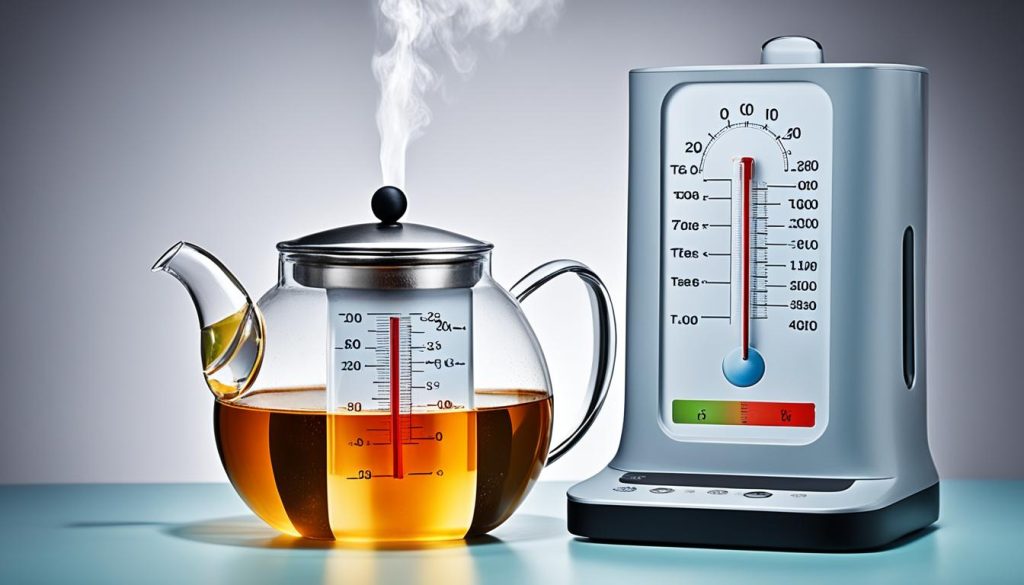
Adjusting Steeping Time for Optimal Flavor
When it comes to brewing tea, steeping time plays a crucial role in achieving the perfect flavor profile. Not only does the steeping time affect the extraction of flavors, but it can also compensate for variations in water temperature and other factors that can impact the taste of your brew.
Shorter Steeping Times: If you prefer a milder and less bitter cup of tea, opt for shorter steeping times. This is especially important for delicate teas like green tea, which can easily become bitter if steeped for too long. By reducing the steeping time, you retain the tea’s natural sweetness and floral notes, resulting in a more enjoyable and balanced cup.
Longer Steeping Times: On the other hand, if you’re looking to extract more flavors and create a robust brew, longer steeping times are preferable. This is particularly true for black teas and certain herbal teas that benefit from extended infusion periods. Longer steeping times allow the flavors to develop fully and intensify the taste profile, resulting in a richer and more satisfying cup.
Ultimately, the optimal steeping time depends on your personal taste preferences and the type of tea you’re brewing. Experimenting with different steeping times can help you find the perfect balance of flavors that suits your palate.
Tips for Adjusting Steeping Time:
- Start with the recommended steeping time for the specific tea variety.
- Reduce steeping time for delicate teas to prevent bitterness.
- Increase steeping time for robust teas and herbal infusions to enhance flavor extraction.
- Take notes of the steeping time and flavor results to refine your brewing technique.
By understanding the impact of steeping time on flavor extraction, you can unlock the full potential of your tea and customize your brew to suit your unique preferences.
The Influence of Teaware on Flavor
The choice of teaware can greatly impact the flavor of your tea. Different materials and designs have varying effects on flavor absorption and taste. Understanding the characteristics of different teawares can help you enhance your tea experience.
Glass Teaware
Glass teaware is an excellent choice for those who want a neutral flavor profile. It does not absorb flavors and allows you to fully appreciate the aroma and color of your tea. Glass teapots and cups also provide a visually pleasing experience, allowing you to observe the beautiful color and unfurling of tea leaves.
Glazed Ceramic Teaware
Glazed ceramic teapots and cups are another popular choice that offers neutral flavor absorption. The glaze layer prevents the tea from interacting with the ceramic material, preserving the true flavor of the tea. Additionally, ceramic teawares can retain heat well, allowing for longer enjoyment of hot tea.
Unglazed Teapots
Unglazed teapots, such as those made from Yixing clay, are highly regarded by tea enthusiasts. The porous nature of the clay allows the teapot to develop a unique patina over time, enhancing the flavor of the tea. Unglazed teapots are often seasoned with specific teas, meaning they absorb the flavors of the tea and subtly enhance subsequent infusions.
Plastic and Metal Teaware
Avoid using plastic or metal teapots and cups if you’re looking to enjoy the true flavors of your tea. These materials can absorb strong tea flavors and transfer them to more delicate brews, impacting the taste and aroma. It’s best to opt for teawares that won’t interfere with the natural flavors of your tea.
Choosing the right teaware can elevate your tea-drinking experience. Consider your preferences, the type of tea you’re brewing, and the desired flavor profile when selecting your teapot, teacups, and accessories.
Troubleshooting Your Brew
If you’re not getting the desired taste from your tea, there are various factors that may be affecting the flavor. It’s important to consider the quality and freshness of the tea, the water source, and the brewing method. Additionally, improper storage can result in a less flavorful brew. By troubleshooting your brewing process, you can identify any potential issues and make the necessary adjustments to enhance your tea experience.
The water source is a crucial element in tea brewing. Different regions have varying water qualities that can impact the taste of your tea. Using filtered or spring water can help ensure a clean and refreshing flavor profile. Avoid using water with strong odors or high mineral content, as it can alter the taste of your brew.
Tea quality and freshness play a significant role in the overall flavor. Invest in high-quality tea from reputable brands to experience the best taste. Stale or expired tea leaves can result in a lackluster brew, so it’s important to check the expiration date and store your tea properly. To maintain freshness, store your tea in airtight containers, away from heat, light, and moisture.
Your brewing method can also affect the flavor of your tea. Brewing time, water temperature, and tea-to-water ratio all contribute to the taste. Experiment with different combinations to find the optimal balance. If your tea tastes too weak, try increasing the steeping time or adding more tea leaves. On the other hand, if your tea tastes too strong or bitter, consider reducing the steeping time or using cooler water.
Remember, troubleshooting your brew is a process of trial and error. By considering the water source, tea quality, tea freshness, brewing method, and tea storage, you can fine-tune your brewing process to achieve the perfect cup of tea with enhanced flavors and an enjoyable aroma.
